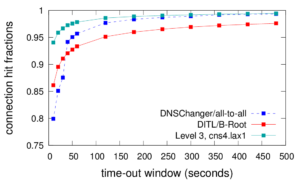We released a new technical report “When the Internet Sleeps: Correlating Diurnal Networks With External Factors (extended)”, ISI-TR-2014-691, by Lin Quan, John Heidemann, and Yuri Pradkin, available as http://www.isi.edu/~johnh/PAPERS/Quan14b.
pdf
![Comparing observed diurnal phase and geolocation longitude for 287k geolocatable, diurnal blocks ([Quan14b], figure 14b)](http://ant.isi.edu/blog/wp-content/uploads/2014/05/Quan14b_icon-300x210.png)
As the Internet matures, policy questions loom larger in its operation. When should an ISP, city, or government invest in infrastructure? How do their policies affect use? In this work, we develop a new approach to evaluate how policies, economic conditions and technology correlates with Internet use around the world. First, we develop an adaptive and accurate approach to estimate block availability, the fraction of active IP addresses in each /24 block over short timescales (every 11 minutes). Our estimator provides a new lens to interpret data taken from existing long-term outage measurements, this requiring no no additional traffic. (If new collection was required, it would be lightweight, since on average, outage detection requires less than 20 probes per hour per /24 block; less than 1% of background radiation.) Second, we show that spectral analysis of this measure can identify diurnal usage: blocks where addresses are regularly used during part of the day and idle in other times. Finally, we analyze data for the entire responsive Internet (3.7M /24 blocks) over 35 days. These global observations show when and where the Internet sleeps—networks are mostly always-on in the US and Western Europe, and diurnal in much of Asia, South America, and Eastern Europe. ANOVA testing shows that diurnal networks correlate negatively with country GDP and electrical consumption, quantifying that national policies and economics relate to networks.
Data from this paper is available from http://www.isi.edu/ant/traces/internet_otuages/index.html, and from http://www.predict.org as dataset internet_outage_adaptive_a12w-20130424.

